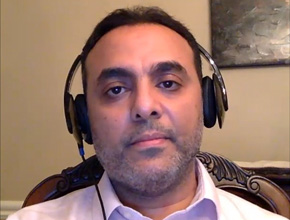Academic degrees of interview participants were revised on May 11, 2020.
Dr Edward Mills, associate professor in the Department of Health Research Methods, Evidence, and Impact, clinical trials advisor at the Bill & Melinda Gates Foundation, and senior principal scientist at Cytel, joins Dr Roman Jaeschke to clarify the concept of platform trials and their significance during the COVID-19 pandemic.
Click here to download slides from the interview.
Roman Jaeschke, MD, MSc: Good afternoon. Welcome to another edition of the McMaster Perspective COVID-19: To Treat or Not to Treat? series. I would like to introduce Professor Edward Mills, who probably knows more than anyone else I know about the new concept of testing treatment efficacies during the coronavirus disease 2019 (COVID-19) pandemic.
Professor Mills, maybe we could start by asking you to introduce yourself.
Edward Mills, PhD: Thank you. I’d be delighted to. I’m a graduate of McMaster University, from about 15 or 16 years ago. I’m associate professor in the Department of Health Research Methods, Evidence, and Impact. The majority of the time I work for a company called Cytel, where I design clinical trials, predominantly for the Bill & Melinda Gates Foundation. The majority of my trials tend to happen in low-income settings, but because of the nature of this pandemic I’ve been pulled into trials here in North America, Europe, and around the world.
Roman Jaeschke: As a methodologist for a number of years, I keep learning, and now I would like to learn about 2 concepts I keep hearing about. One of them is called “platform trials,” and the other is “adaptive trial results.” Both have been popping up in the setting of the COVID-19 pandemic. Could you take us through it?
Edward Mills: I’d be delighted to.
The funny thing is that probably for the last 5 years I’ve been working on adaptive trials, I’ve been singing praises of them but getting very little attention about this topic. It’s only since this pandemic came along that people recognized there’s a need to move as swiftly as possible, and for that reason adaptive trials have in fact become almost the new norm for evaluating interventions in the COVID-19 scenario.
I have some slides to share. The first slide demonstrates the general outline of a platform trial. A platform trial is usually designed with multiple arms. Then they follow patients and do various preplanned looks at the data. Depending on what kind of message the data is sending in the interim evaluations, you may decide to drop, change, or add an arm. You could begin a trial with just 2 interventions, for example, then do an evaluation and add another arm if the findings were inconclusive, or perhaps you’ve been convinced at that stage to drop an arm. The majority of the big trials, the multicenter and multicountry trials occurring within COVID-19, are platform trials at the moment.
Roman Jaeschke: If I could ask you a question in a maybe simpler language: In a platform trial you essentially are taking potentially different interventions, or interventions A, B, and C, and you could randomize people to intervention A or no intervention A, to intervention B or no intervention B, or to intervention C or no intervention C. Correct?
Edward Mills: Correct. And they can share a control arm or the comparison between arms.
Roman Jaeschke: So you may end up being subjected to all 3 interventions, a combination of 2 interventions, a single intervention, or—rarely—none of them. Correct?
Edward Mills: Not really. In a classic platform design you would randomize people into one of several arms, let’s say 1 of 3, then follow them for some period. At the end of that period you look at the data. If you decide that the data tells you to drop an arm—because it’s futile, harmful, or it’s convincingly good—you can drop an arm at that stage and add an arm. You may want to rerandomize patients within a trial, but we don’t generally see that.
Roman Jaeschke: OK. Keep going, I interrupted you.
Edward Mills: Traditional randomized controlled trials (RCTs) usually have 2 arms and a set period of time when we’re going to follow the patients. With adaptive designs we’re allowing the data to inform us about what’s occurring within a trial, to inform us whether there’s convincing evidence emerging from the trial of futility, harm, or treatment effects. For that reason we’re trying to evaluate multiple interventions at the very same time. This is an effort to speed along decision-making.
The REMAP-CAP (Randomized Embedded Multifactorial Adaptive Platform for Community-Acquired Pneumonia) trial is one of the highest-profile trials occurring within the COVID-19 epidemic. It’s a multiarm trial that was already going on for community-acquired pneumonia prior to the pandemic. Very cleverly, they had a pandemic arm preplanned for the last several years. At the beginning of March they realized that they needed to activate this arm. So the REMAP-CAP trial was a platform trial that was already going on and has now enrolled patients in more than 50 different settings around the world.
There are 6 different master protocol and platform trials going on at the moment. A master protocol is the overarching name for different designs of multiarm evaluations. It’s perhaps not the best name for a trial design because it can mean so many different things to different people. You could have a platform trial, which we’ve just discussed. You could have a basket trial, where you’re looking at different interventions for a similar population and following them over time. You could have an umbrella trial, where you’re looking at related populations. With COVID-19 patients, we might look at mild-disease patients and treat them in one way, and we might look at more severe hospitalized patients and treat them with either the same interventions or combinations of interventions, all occurring within one trial. A clinician would probably say that these are different populations. Indeed they are, but they can occur within one trial, because a patient can graduate from one aspect of it into the next.
One of the highest-profile trials going on at the moment is the SOLIDARITY trial, hosted by the World Health Organization (WHO). The SOLIDARITY trial was designed by the WHO and has the overarching data safety monitoring committee at the WHO run by academics around the world. The reason that was put in place is because it became obvious early on there was a heterogeneous quality of clinical trials going on at the moment. There was a recognition, having learned from the Ebola epidemic, that we can’t have dozens and dozens of trials going on that are not linked. We need to be able to learn from the different sites.
Now there are 17 different countries participating in SOLIDARITY as of today. It’s 5 different interventions among hospitalized patients. It’s a unique trial because it is this multicountry and because there doesn’t appear to be any shortage of patients for this trial. Some interesting methodological elements are that there is no sample size calculation to determine whether you’ve got enough patients, they have no prespecified stopping rules, and they have no predetermined interim evaluations.
We will see how this goes. It’s never been done before. I think a lot of people are watching to see how it goes. Canada has their own office for the SOLIDARITY trial, and I believe there are several intensive care units (ICUs) participating.
Roman Jaeschke: I cannot see your slide at the moment. Could you remind us what is being tested? Because what’s being tested is also an indication of where the equipoise is, at least according to some people.
Edward Mills: The different arms in the SOLIDARITY trial are remdesivir and supportive care; hydroxychloroquine and supportive care; Kaletra (lopinavir/ritonavir) and supportive care; Kaletra, interferon, and supportive care; and the control arm is optimized supportive care.
There is some reason to believe that emerging evidence is reducing our enthusiasm for some of these interventions.
Roman Jaeschke: Thank you for correcting my misconception about platform trials. That’s very useful to me already. Maybe we’ll go now to how those designs are at the moment employed around the world in the face of the COVID-19 pandemic.
Edward Mills: I would like to bring the audience’s attention to a tool that they might find useful. It’s the COVID-19 Clinical Trial Tracker that we built with the support of Fast Grants and the Bill & Melinda Gates Foundation. You can find it at www.covid-trials.org. On a day-to-day basis we search all of the clinical trial registries around the world to find out what trials are registered, what trials are recruiting, and what trials might have finished. We’ve plotted them according to geography as well as the methodological aspects. If you visit the site, you’ll be able to follow what’s of interest to you.
You’ll find it interesting that a large amount of the trials began early March. We now have over 590 randomized trials that have been registered in just a month. This is unprecedented in medical history. We’ll see how many of them end up reading out. What we are finding is that there was a lot of trials that were registered and even enrolled in China, for example, but within a short period of time the number of cases in China has gone down dramatically and as a result of that many of those trials are probably unlikely to finish.
However, if you look at these 590 trials, I think it tells an interesting story. The majority of these trials, about 50% of them, only investigate 1 intervention versus a control. The majority are also small trials, of a sample size less than 100 participants. This indicates that we need to have larger trials that evaluate more interventions than just 2 arms will allow.
Certain treatments are being particularly overinvestigated and repeated again and again. For example, chloroquine or hydroxychloroquine features as a treatment in 118 separate trials. Even though there’re 590 trials, a large [number] of them are hydroxychloroquine, and it may well turn out very soon that there’s convincing evidence that hydroxychloroquine may not be effective.
If you look at the geographic spread of the trials, it tells us that the majority of trials were initiated in East Asia, 334 in China, and virtually none in Africa. There are 11 trials registered in Africa, 7 for South Asia, and only 12 for South America, and yet these are the settings that have the weakest health systems. So as COVID-19 does take hold in those environments, we’re going to immediately need clinical trials. I’m part of several trials that we’re hoping to get funded in those settings, but we’re going to have to wait and see if that occurs.
I also think it’s useful for you to look at what the network of interventions looks like. We can see that among the hospitalized patients, outpatients, prophylaxis populations, and health-care workers there’s an overrepresentation of the few different interventions: hydroxychloroquine, azithromycin, lopinavir, and remdesivir. What we really need is more interventions should those fail. We need to have backup interventions to consider.
There is a pipeline of biotech interventions coming. The initial thoughts on how to respond to a pandemic were about, “Can we repurpose drugs right away while we’re waiting for biotech companies to develop new interventions?” And that’s what’s happening. We’re quickly running out of options on this repurposing, though, so we need to get new molecules into clinical trials.
In conclusion, I would say this represents in some ways a disconnected research effort, but in other ways this is a historic event in terms of unprecedented collaboration and unprecedented efforts to get into clinical trials as quickly as possible. Unsurprisingly, as time goes on we’re going to get better organized about how to do the trials. I really pray, just like everybody else, that the COVID-19 epidemic goes away, but we will also have learned so much from this epidemic that I hope we can bring in to how we do future clinical trials. We could be at an era where the new norm is far more efficient.
Roman Jaeschke: A great review of the topic. It sounds like heaven for people who will be doing meta-analyses down the road. I pray with you that at least one of those drugs will become very effective. It’s a real pleasure to talk to you. Thank you.
Edward Mills: Thank you.
 English
English
 Español
Español
 українська
українська











